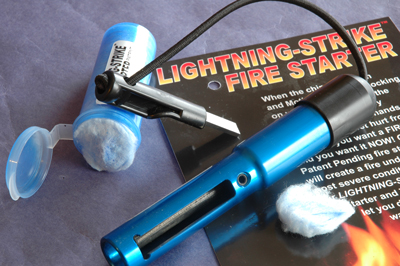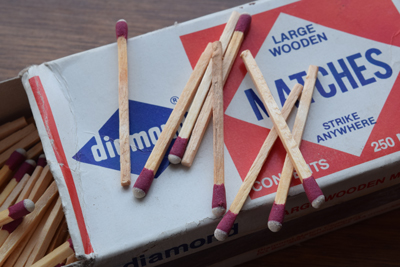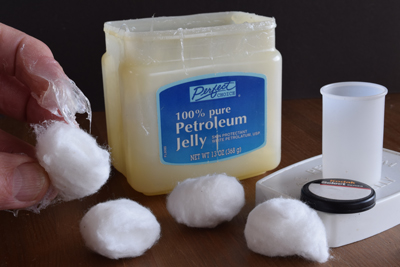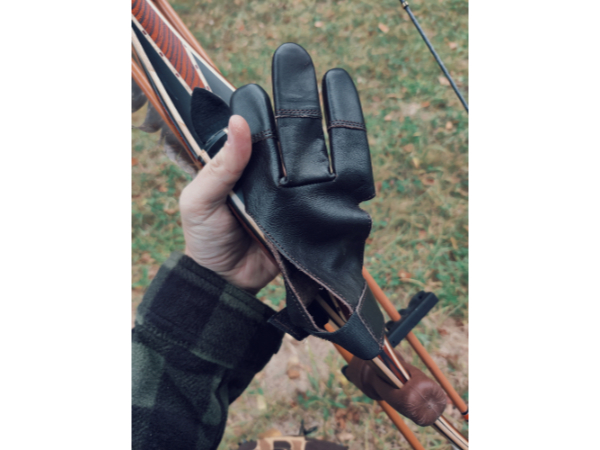The man on the Yukon trail wasn’t worried. “Fifty degrees below zero was to him nothing more than 50 degrees below zero.” He would be at camp, with friends and a fire, by evening. Winter’s sun was elsewhere, the whiteness oddly dark. Morning wore on without marking time. The man’s spit crackled in the air; a tobacco-hued icicle hung from lips that stuck when he pressed them together. When he removed a glove to reach his lunch, his fingers were almost instantly numb, as were his toes. At 75°F below zero, 107 degrees of frost, he’d given little thought to “man’s general weakness, to live only within narrow limits of heat and cold.” But when fragile ice over running water gave way, plunging him to his knees, he knew he would have to stop to build a fire.

Darrell Holland’s Lightning-Strike unit packs easily. No parts to lose. Dry-fiber fuel weighs little.
Jack London’s short story, “To Build A Fire,” was published in 1902. It tells of a man imperiled not only by cold and distance, but also by his own folly, and a cascade of small oversights that impair his ability to recover from one single mistake. When a spark wrests a tiny flame from his precious tinder, he adds fuel. The flame climbs. He is saved! But with an eye to the fire, he’s neglected to consider its effects. Conifer boughs above, shaken by his snapping of branches, and perhaps slippery now from the heat, shed their burden of snow. It falls with grim finality on what would be the man’s last legitimate bid for life.
I’ve slept in winter on the crest of Oregon’s Wallowa Mountains, where my breath fell instantly back as ice crystals onto my face. The mercury hovered at 26 below. That was a chilly night, but tolerable in my down bag. Hunts have left me bitterly chilled in warmer air, courtesy of wind and water, inactivity, and humidity. My preferred antidote is movement that bumps pulse, perhaps getting out of wind and rain or into the sun. But storms and terrain can trim those options. If you’re hunting with other people who’ve counted on you to remain at a certain stand, or rendezvous for a ride back to a distant camp, bounding off to cheerier climes or returning early to camp may not be practical.
Sometimes a fire isn’t practical either—mainly when restrictions are in place to prevent wildfire. But generally, those are imposed in warm, dry weather.
Confession: Even in conditions that beg a fire, I don’t like building one. When I’m bowhunting, a fire seems an anchor, taking my focus and energies from the hunt, and keeping me too long in one place. Even in late, snowy seasons in the Mountain West where elk hunters customarily set fire to stumps to make day-long trail-watching tolerable, I’ve preferred to walk.
Besides, I’m not very good at building fires.

On hunts, carry fresh wooden, strike-anywhere matches in a waterproof container, and a friction strip.
“You each have matches, and there’s plenty of dry wood and kindling around. No paper allowed. We have dozens of hot dogs.” So began, as I recall it, a gray winter day in Michigan that put my skills on the line. Our Boy Scout troop would stumble about the woods in freshening wind straight from Kotzebue.
My fingers, in cheap brown Jersey cotton, were soon numb. At last a miserable wad of expired twigs and brittle grass charitably yielded a tendril of smoke. My hot dog that day was roasted to body temperature.
Native Americans surely fared better. My modest library turned up a book titled 3001 Questions and Answers. This paperback pocket-size tome has 295 pages chock full of fine print on a wide range of outdoors lore. It is not current. Topics range from waterproofing canvas canoes to bounties on hawks and owls, home-made gunpowder to skunk-farming. Many of the 3,001 queries have to do with hunting dogs and homesteading and food, wild plants to flapjacks. There’s one on fire-building. One! In that era of cut-shells and BB caps, deadfalls and Oneida jump traps, everyone knew how to start a fire. The single entry on the subject seemed borne of curiosity: How did Indians make fire?
Answer: “Indians had no steels, but they used flint against flint…. The bow method was simply a bow, with a string. The string was put around a stick and one end of the stick put in a pile of punk, or dry powder wood, and then by working the bow back and forth—fiddling—the end of the stick was heated by friction and after a time, smoke and then a spark came….”
Another book, Camp and Trail Methods, by the same publisher (Harding, Columbus OH) has no reference to fire in its table of contents, whose 19 chapters consume 278 pages.

About the size of a pocket knife, Ultimate Survival’s BlastMatch striker can be used with one hand.
Was fire-starting that easy? Well, it had been both easy and difficult, depending on conditions. As it is now. The difference: At the dawn of the automobile age, rural folk were still steeped in fire-building from an early age. No matter the time and effort required, they made fire because it was necessary.
I’ve made fire with bow and peg, but not quickly. Coached by a guru in this art, I fumbled to keep the peg vertical while the bow’s encircling string tugged it back and forth as much as it imparted rotation. Eventually the carefully stored wood particles and shavings at the foot of the peg smoldered. My coach cupped his hands and blew a little but not too much, tickling the tip of a flame.
This is not something you can do handily in the woods when you suddenly want a fire. The bow-and-string and peg are best fashioned beforehand. The wood base on which the peg bears must be stable and contoured to accept the peg and fuel, which must be dust-dry and very fine. You’ll need progressively coarser but equally dry shavings, then twigs, ready at hand.
Neither is flint a panacea. Flintlock rifles work well, given the hammer’s strong spring and fast strike. Fixed positions of flint and frizzen ensure an ideal strike angle. And gunpowder in the pan ignites readily. In hand, however, producing and directing a thick shower of sparks from flint and steel demand much of your grip and persistence. And their effect is gone in a blink if tinder doesn’t instantly ignite.
Matches were a great invention. The only type worth taking to the woods is the stout, big-headed, strike-anywhere variety. Metal water-proof match containers popular in my youth are still useful, albeit they won’t keep matches fresh. Over time, especially in humid climates, matches lose their zip. Replace the matches in your container each hunting season. While lighting matches on the fly of your trousers may be a point of pride, remember that in the woods zippers can get cold and wet. Carry a flap of fine sandpaper taped to a small block.
As even the most enthusiastic matches are quickly consumed, many hunters use cigarette lighters to start fires. The best are reliable, provided you check their fuel. I’ve found cheap lighters unreliable, and their flames weak when you must battle wind, rain, snow, or damp kindling. Commercial fire-starters for outdoorsmen and -women include two that have impressed me.
The first is from Darrell Holland, whose inventive mind often strays from his long-range shooting schools and the custom rifles he builds in his Oregon shop. The Lightning-Strike Fire Starter, in weight and dimensions like a small flashlight, contains a striker on an elastic cord that delivers a veritable cloudburst of sparks. Holland furnishes a stack of easily ignited, cotton-like wads in a tube little bigger than a 12-bore shotshell. Each wad bursts instantly into flame that lasts minutes, until your tinder lights up. The starter’s hollow end protects the wad at ignition (hollandguns.com).
Another metal-striker device, BlastMatch, hails from Ultimate Survival Technologies. Conceived by a Special Forces veteran for use by downed pilots, it comes in a hard polymer case about the size and weight of a big pocket-knife. It’s cleverly designed to operate with one hand, a big advantage if your other is injured or frozen. Individually wrapped lozenges (BlastMatch Fire Starting Tinder) can be shaved into shards that ignite even on the surface of water! A tablet can burn for several minutes and, after your sticks are burning cheerily, repackaged for later use (ultimatesurvival.com).
Both Holland’s Lightning-Strike Fire Starter and Ultimate Survivor’s BlastMatch are affordable and portable. Each has a long shelf life.

Wayne’s fire-starting tinder is Vaseline-saturated cotton balls, carried in a plastic 35mm film can. With your fingers, work Vaseline into cotton balls. They light easily, burn briskly for over a minute.
A cheap, reliable fuel I’ve used to start fires is cotton fiber saturated with Vaseline. I use ordinary cotton balls, kneading Vaseline into each with my fingers. Then I stack them in plastic 35mm film cans. Capped, these lightweight, waterproof containers go into my daypack. Placed under a small pyramid of kindling, each cotton ball lights eagerly and burns enthusiastically for a minute or so—surely long enough to ignite wood. There’s no obnoxious smell.
I’ve had plenty of trouble starting fires in the woods. Mainly that’s because I don’t start fires until I’m tired, cold, impatient, and invariably in a wet place. The time to start a fire is before you need it, when you’ve time, daylight, and energy to gather proper fuel and take every care to ensure first-try ignition.
Fog that disorients, storms that impede travel, and cold and wet weather that chills can bring trouble on quiet feet, faster than you’d expect. If you’re injured or lost, or rendered immobile for more than a few hours, hypothermia can be fatal. But shy of such dismal fortunes, a fire improves your health. A fire can feed and cheer you, help you think clearly and optimistically.
Nearly 40 years ago a Canadian trapper told me, “I carry a wiener and tea. So, I have to stop for a bit and build a fire. If I packed a sandwich I’d eat it on the trail, where dark thoughts can find me.” I’ve remembered that. It helps me fumble through the makings of a fire.







Leave A Comment